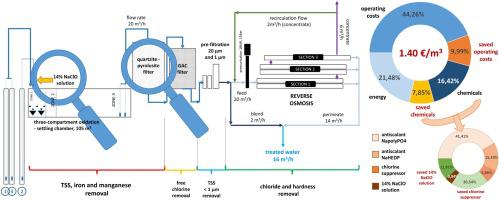Journal of Water Process Engineering ( IF 7 ) Pub Date : 2021-03-15 , DOI: 10.1016/j.jwpe.2021.102013 Alberto Cerutti , Giuseppe Campo , Mariachiara Zanetti , Barbara Ruffino

|
Water is an essential ingredient in wine production. The winery plant considered in this study, located in the Langhe area (Piedmont, NW Italy), used approx.100,000 m3 per year of high quality water for cleaning and sanitation operations. Water was collected from the local shallow aquifer and contained high concentrations of dissolved iron (Fe(II), 800 – 3500 μg/L) and manganese (Mn(II), 300–700 μg/L). The water treatment plant (WTP) owned by the winery included a series of treatment processes (air sparging and sodium hypochlorite injection, settling, filtration on a quartzite – pyrolusite filter, removal of excess chlorine with an activated carbon filter and, finally, microfiltration and reverse osmosis, RO) that were deemed to be adequate to make the groundwater compliant with potable uses. However, a survey carried out by the authors revealed the presence of two critical issues in the WTP’s management, concerning the Fe(II) and Mn(II) oxidation and removal, and the backwashing of the dual media filter. Firstly, the results of pilot tests demonstrated that the process of air sparging was sufficient for the oxidation of iron and that NaClO was not necessary for that operation. The present concentration of pure oxidant, of 21.5 mg NaClO/L, could be reduced by at least 75 %, without altering the capacity of the WTP in the removal of the two metals. Secondly, a new combination of water fluxes could improve the efficiency of the dual media filter backwashing, thus allowing to simultaneously avoid the use of the RO corrosive concentrate and to minimize the use of high quality water.
In the end, a very basic cost model was used to compare the unit cost for water treatment in the current scenario and after the introduction of the two proposed solutions. Specifically, that model considered three cost items: operating costs (that included four sub-items: mortgage, maintenance, consulting and cost for non-amortizable raw materials and consumable), the costs for the purchase of the chemicals necessary for the water treatment process, and the energy costs. The results coming from the application of the cost model demonstrated that the introduction of the proposed solutions into the WTP, at no additional costs, had an undeniable positive impact on the final unit cost of the treated water, that was reduced by 20 %.
中文翻译:

意大利酿酒厂中水处理工艺的优化:一个案例研究
水是葡萄酒生产中必不可少的成分。本研究中考虑的酿酒厂位于朗格地区(意大利西北部皮埃蒙特),使用了约100,000 m 3每年用于清洁和卫生操作的优质水。从当地浅层含水层收集水,其中含有高浓度的溶解铁(Fe(II),800-3500μg/ L)和锰(Mn(II),300-700μg/ L)。酒厂拥有的水处理厂(WTP)包括一系列处理过程(空气喷射和次氯酸钠注入,沉降,在石英岩上的过滤-软锰矿过滤器过滤,用活性炭过滤器除去过量的氯,最后进行微滤和反渗透,RO)被认为足以使地下水符合饮用水的使用要求。然而,作者进行的一项调查显示,污水处理厂的管理中存在两个关键问题,分别涉及Fe(II)和Mn(II)的氧化和去除以及双介质过滤器的反冲洗。首先,中试测试的结果表明,空气喷射过程足以使铁氧化,而NaClO对于该操作而言则不是必需的。目前的纯氧化剂浓度为21.5 mg NaClO / L,可以降低至少75%,而不会改变WTP去除两种金属的能力。其次,水通量的新组合可以提高双介质过滤器反冲洗的效率,从而可以同时避免使用RO腐蚀浓缩液,并最大限度地减少了高品质水的使用。而不改变WTP去除两种金属的能力。其次,水通量的新组合可以提高双介质过滤器反冲洗的效率,从而可以同时避免使用RO腐蚀浓缩液,并最大限度地减少了高品质水的使用。而不改变WTP去除两种金属的能力。其次,水通量的新组合可以提高双介质过滤器反冲洗的效率,从而可以同时避免使用RO腐蚀浓缩液,并最大限度地减少了高品质水的使用。
最后,使用了一个非常基本的成本模型来比较当前方案中和引入两种拟议解决方案后的水处理单位成本。具体而言,该模型考虑了三个成本项目:运营成本(包括四个子项目:抵押,维护,咨询和不可摊销原材料和消耗品的成本),购买水处理过程所需的化学药品的成本,以及能源成本。应用成本模型得出的结果表明,将建议的解决方案引入WTP无需支付额外费用,对处理后的水的最终单位成本产生了不可否认的积极影响,减少了20%。



























 京公网安备 11010802027423号
京公网安备 11010802027423号